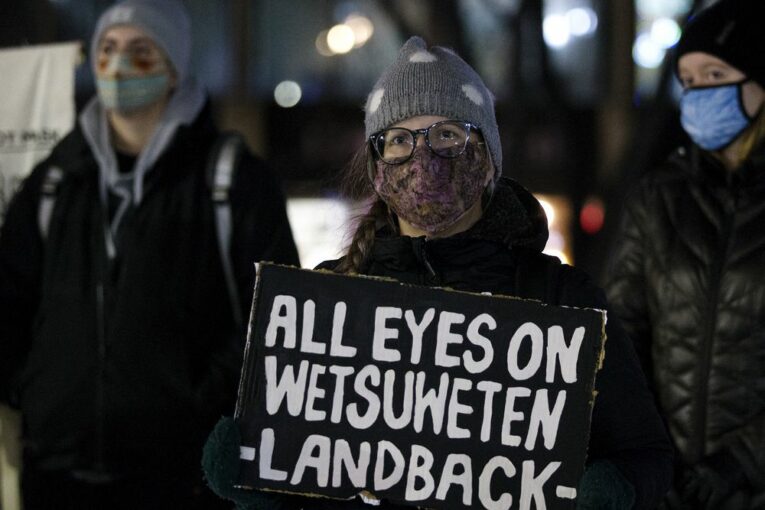
CALGARY — After weeks of delays, crews and equipment moved onto a controversial drilling site that had been occupied and blockaded by protesters for 56 days near the Morice River in northern British Columbia along the path of the under-construction, $6.7-billion Coastal GasLink pipeline.
The drilling location is the site where Coastal GasLink plans to install the pipeline below the Morice River. The location has become the source of heightening tensions since Oct. 5, when supporters of a Wet’suwet’en hereditary chief opposed to the pipeline issued a call to action to “rise up again” against the Coastal GasLink, which would connect gas fields in northeastern B.C. with the $40-billion LNG Canada export project near Kitimat.
Answering the call, protesters occupied the drilling site and established “Camp Coyote,” where they seized equipment, felled trees, tried to destroy the drilling pad and, in the end, blockaded the Morice River Forest Road that is used to deliver essential supplies to Coastal GasLink work camps housing 500 people.
The same road became the source of conflict and international attention in January and February 2020, when a group of hereditary Wet’suwet’en chiefs blockaded the road with supporters. Their arrests led to a wave of protests across Canada at the time, blockaded railway lines across the country and heightened tensions between Ottawa and Indigenous communities.
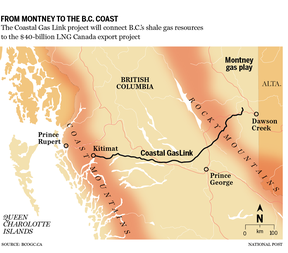
At the time, federal and B.C. provincial ministers flew to northern British Columbia in an attempt to meet with the opposed hereditary chiefs and those meetings resulted in the signing of a memorandum of understanding on the subject of Wet’suwet’en rights and title and on the construction of the Coastal GasLink pipeline.
Ottawa has been working to “focus on the implementation of Wet’suwet’en rights and title” ever since the MOU was signed in Feb. 2020, a spokesperson for Crown-Indigenous Relations Minister Marc Miller said in a statement.
“Despite current developments, we remain steadfastly committed to this process,” the statement noted.
The federal government put itself in a “difficult position” by signing the MOU on May 14, 2020 because the document enumerated items that needed to be negotiated over the following three months and additional items to negotiate over the following 12 months, said Dwight Newman, Canada research chair in Indigenous rights in constitutional and international law at the University of Saskatchewan.
Those issues that called for further negotiation “would be complicated things to negotiate and I don’t see how anyone would have thought that those were going to get negotiated on three-month timelines.”
“I guess it’s a caution to governments not to commit to impossible timelines on negotiations,” Newman said, adding that the outbreak of the COVID-19 pandemic likely would have slowed down negotiations “but even if COVID had not hit, these wouldn’t have been simple negotiations.”
Partially as a result of slow progress on issues contained in the MOU, tensions have again flared in northern B.C. between the hereditary chiefs and the pipeline company, but also between First Nations supporting the pipeline and the group opposed to the project.
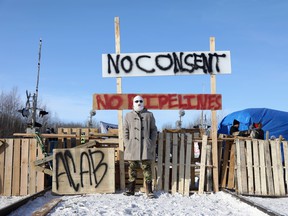
To date, there have been only a few solidarity protests in Victoria, Vancouver and Edmonton in support of the opposed Wet’suwet’en chief following the second wave of arrests along the Morice River Forest Road.
Enforcing a court order on Nov. 18 and 19, B.C. RCMP mounted what they called a “rescue and enforcement” operation and arrested 29 people. On Friday, Nov. 19, RCMP reported finding blockades, two buildings and “a wood pile that was on fire directly around a drilling site.”
Photojournalist Amber Bracken, on assignment for environmentally focused website the Narwhal, was among those arrested. She and documentarian Michael Toledano , who is producing a film on behalf of the protesters, were released following a bail hearing on Monday on the condition that they appear in court in February. They must also comply with the terms of the injunction order first granted to Coastal GasLink by the same judge in December 2019.
Police say the entire operation was documented through the use of video and body cameras “for court or complaint purposes.” A release from the RCMP also says it is “completely false” that it used “attack dogs” or excessive force to make the arrests .
“The government of Canada does not want the world to witness the violence that police bring to Indigenous people,” Jennifer Wickham, who is opposed to the project and producing a documentary film about the resistance called Yintah, said in a release.
The release, which describe the arrests as “a violent raid,” noted that protesters had occupied the drilling site for 56 days. Police and TC Energy Corp., which is building Coastal GasLink, say the protesters also occupied the forestry road for four days and that blockade kept essential supplies including food and fresh water from reaching 500 workers in camps.
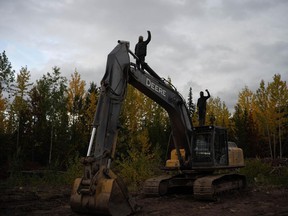
Not all Indigenous groups support the protests.
The blockade drew swift condemnation from elected Wet’suwet’en First Nation chief Maureen Luggi and councillors Karen Ogen and Heather Nooski, who noted in a release that some of the 500 workers trapped behind the blockade are Wet’suwet’en workers. “We fear for their safety and well-being now that their lines of supply and communication are being disrupted.”
“We want to make it clear that the actions of a few members of the Gidimt’en Clan who claimed to evict Coastal GasLink and the RCMP from the headwaters of the Morice River (Wedzin Kwa in our language) do not represent the collective views of the clan or of most Wet’suwe’ten people,” the three elected leaders wrote in the release.
“Even though we are also members of the Gidimt’en Clan, the protesters at the ‘Coyote Camp’ and other protest sites have never consulted us about their actions and cannot claim to represent us or any other members of the First Nation.”
Further along the pipeline route, where LNG Canada is in the midst of constructing the first phase of its liquefaction and export facility, the Haisla Nation expressed its concern over the blockades and reiterated its support for the project. The LNG Canada project is currently under construction in Haisla territory, and the nation has since embarked on advancing another project called Cedar LNG and brought Pembina Pipeline Corp. onboard as a partner.
“I know I speak for all of our members when I say we hope for a peaceful resolution to what is taking place on the Coastal GasLink pipeline route,” Haisla chief councillor Crystal Smith said in a release.
Smith reiterated that her nation “supports LNG development as a means of supporting our nation’s financial, educational and social development.”
TC Energy confirmed it was able to deliver food and water to its 500 workers in the evening of Nov. 18, after the first of the 14 people at the protest sites were arrested. The company confirmed that work on other sections of the project had continued during the protests and operations had resumed at the drill site.
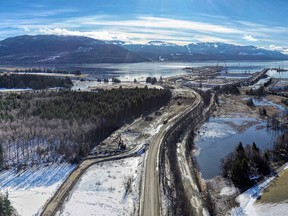
Delays in building the Coastal GasLink pipeline has also been a source of tension between TC Energy and LNG Canada, the consortium led by Shell Canada Ltd., and a brewing financial dispute between the two companies.
“LNG Canada respects the rights of individuals to peacefully express their points of view, as long as their activities do not jeopardize people’s safety and are within the law,” LNG Canada said in a release, adding that 20 First Nations along the route support the project.
“We also recognize that (Coastal GasLink) has made numerous efforts to engage with Wet’suwet’en Hereditary Chiefs over the years to understand their concerns and act on their recommendations,” the company said, adding that it would “continue to honour the commitments made to” elected First Nations that support the project.
The protesters arrested along the Morice River Forest Road were released on bail in hearings on Nov. 19 and Nov. 22 on conditions that they not return to the site of the protests and only engage in protests that were “lawful, peaceful and safe.” They face additional hearings on Feb. 14 for civil contempt for breaching the terms of an injunction preventing them on the site.
On Monday night, protesters marched in solidarity through downtown Edmonton and lit a vigil, with a propane fire pit, on the city’s High Level Bridge, where they blocked traffic. Protesters vowed to continue fighting the pipeline.
Molly Wickham, who goes by the traditional name Sleydo’, said on behalf of the protest group that “if TC Energy thinks that raiding Wet’suwet’en territory will stop the resistance against this project they’re dead wrong.”
Still, there have not been country-wide blockades of railway lines and highways that took place in early 2020 following the current round of arrests, though experts are concerned the issue could continue to flare up.
“We could end up right back there,” said Newman at the University of Saskatchewan. “One path forward might be the Canadian and British Columbia governments re-engaging with the issues they had signed in the memorandum of understanding. If they do that, perhaps they’ll get back to affairs when that had been in place.”
With additional reporting from The Canadian Press
• Email: [email protected] | Twitter: geoffreymorgan
_____________________________________________________________
If you liked this story, sign up for more in the FP Energy newsletter.
______________________________________________________________
You can read more of the news on source
